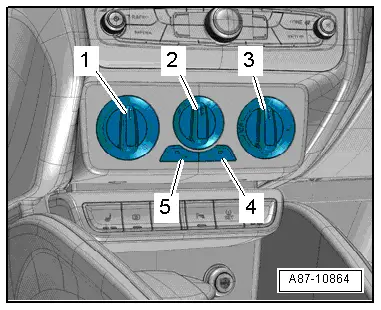| Special tools and workshop equipment required |
| t
| Commercially available thermometer (for measuring temperature; if applicable use thermometer with 2 probes for simultaneous measurement of temperature e.g. on right and left) |
| l
| If the coolant circuit is not completely bled after filling, air may accumulate in the heating system heat exchanger and thus reduce the heat output. In addition, noise may occur or complaints may be received about differences in the temperature of the air from the vents. |
| Remedy if there is poor heating output or noise from the coolant circuit |
| –
| Perform a test drive at fairly high engine speed (at least 10 minutes, engine speed above 2500 rpm). Select a low gear when doing so to prevent an excessively high vehicle speed. |
| –
| In the event of complaints about poor heat output at certain engine speeds, check incorporation of the heating system heat exchanger into the engine coolant circuit → Rep. gr.19. |
| Test prerequisites for attaining maximum heat output |
| l
| All air ducts, covers and seals OK and properly installed |
| l
| Air flow in dust and pollen filter not impaired by dirt; checking → Chapter |
| l
| Engine at operating temperature |
| l
| Flexible shaft and operating lever of temperature flap OK and properly fitted. |
| l
| Foam seal at heating system heat exchanger OK → Chapter. |
| l
| On vehicles with TDI engine, operation of supplementary heater and actuation by heater control unit -J65- OK → Chapter. Check in
„Guided fault-finding“ function, supplementary air heater → Vehicle diagnostic tester„Guided fault-finding“, TDI engine. |
| l
| Actuation of engine control unit by heater control unit -J65- OK. Check in
„Guided fault-finding“ function, TDI engine → Vehicle diagnostic tester. |
|
|
|
 Note
Note Note
Note
 Note
Note Note
Note